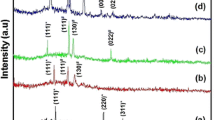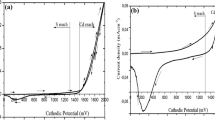Abstract
Cadmium Selenide is an excellent II–VI group semiconducting material due to its capable applications in diverse fields. Thin films of Cadmium Selenide and Zinc doped Cadmium Selenide were grown on tin oxide substrate through potentiostatic electrodeposition technique. Structural examinations showed that both type of deposited layers have hexagonal structure with most prominent reflection along (002) plane. The structural parameters crystallite size, microstrain, dislocation density were estimated for pure CdSe and Zinc doped Cadmium Selenide thin films. Morphological features with elemental composition confirmed the incorporation of Zinc into the crystal lattice of Cadmium Selenide and the smooth nature of the deposited films. Optical absorption measurements were also carried out for grown films and the associated optical parameters were estimated. Photoelectrochemical cells were constructed for CdSe as well as Zn incorporated as photoelectrode with Na2S,S KOH as redox electrolyte and the power output characteristics are investigated.















Similar content being viewed by others
References
R. Bhargava (ed.), Properties of Wide Band Gap Semiconductors (INSPEC Publications, London, 1997)
T. Hussain, M.F. Al-Kuhaili, S.M.A. Durrani, H.A. Qayyum, Results Phys 8, 988–1000 (2018)
S.A. Jesuraj, S. Devadason, M.M.D. Kumar, Mater. Sci. Semicond. Process. 64, 109–114 (2017)
T.C.M. Santhosh., K.V. Bangera, G.K. Shivakumar, Mater. Sci. Semicond. Process. 68, 114–117 (2017)
V.S. Raut, C.D. Lokhande, V.V. Killedar, J. Electroanal. Chem. 788, 137–143 (2017)
S.M.K. Ramamurthi, R.R. Babub, Thin Solid Films 660, 23–30 (2018)
K. Sharma, A.S. Al-Kabbi, G.S.S. Sainic, S.K. Tripathi, J. Alloys Compd. 651, 42–48 (2015)
Joined Council for Powder Diffracted System International Centre for Diffraction Data 2003, PDF No. 08 0459 2980, Pennsylvania, USA
B.D. Cullity, S.R. Stock, Elements of X-Ray Diffraction, 3rd edn. (Pearson Publishers, London, 2001)
Author information
Authors and Affiliations
Corresponding author
Rights and permissions
About this article
Cite this article
Thanikaikarasan, S., Perumal, R. & Venkatamuthukumar, J. Influence of Zinc incorporation in electrodeposited CdSe thin films from aqueous acidic media. J Mater Sci: Mater Electron 30, 1500–1509 (2019). https://doi.org/10.1007/s10854-018-0421-2
Received:
Accepted:
Published:
Issue Date:
DOI: https://doi.org/10.1007/s10854-018-0421-2




